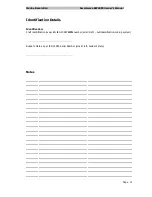
Marine Revolution
Smartwave SW4800 Owner’s Manual
Page
9
Ensure both drain bungs have been secured before launching the boat
Steering System
Your Smartwave SW 4800 may be fitted with a cable or Hydraulic steering system. The steering shaft
running through the engine tilt tube should be lubricated periodically to ensure smooth and trouble
free operation. If at any time the steering becomes stiff to operate, please have a qualified service
engineer inspect the system.
Crew Safety
This boat does not require any specific devise to re-board due to its characteristics.
Re entry at the stern of the boat is recommended and demonstrated in pictures on page 4.
Additional Safety information
Lifebuoys
You may wish to carry a lifebuoy onboard for additional safety.
Lifebuoys are a safety aid that can be thrown to a man overboard (MOB) casualty. A lifebuoy should
be mounted where it can quickly be thrown overboard. It should be marked with the boat's name and
retro reflective tape and fitted with a drogue to prevent drifting, a whistle to attract attention and an
automatic light (projecting a continuous beam) or a strobe. Length of floating line can also be fitted
to aid in the retrieval on the causality in choppy conditions.
Throwing lines
A throwing line should be carried for instant use on deck, regardless of whether the boat is fitted with
a lifebuoy. The brightly coloured floating line is coiled inside a throwing sack, with a wrist-loop or
handles to retain the pulling end. Achieving a long distance throw with good accuracy requires
practice.
Safety Checks
•
Make sure everyone onboard knows how to use a life jacket, flares and operate the radio in
case of an emergency
•
Check your vessel is in good order before you leave
•
Someone onshore is aware of your journey and times of arrival and departure
•
Check the weather
•
Everyone has warm and waterproof clothing
•
Check the engine is in good working order and has been maintained in accordance with the
manufacturers handbook
•
Make sure you have enough fuel for your journey and spare fuel
•
Carry an alternative means of propulsion like oars
and the anchor and warps are in good
conditions
•
Make sure you have enough lifejackets and emergency flares
•
Be sure all fire extinguishers are in date and ready for use
•
Check your radio equipment is operational
•
Check you have food and water and some spare in case you have to spend more time at sea
than you planned.






























